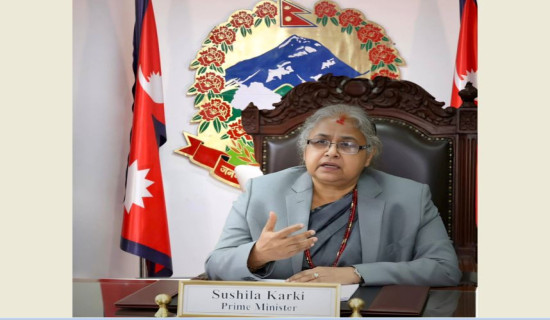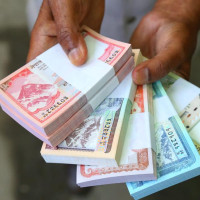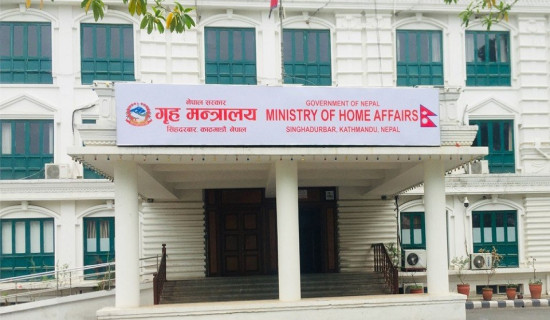- Monday, 20 October 2025
70th Year of Nepal-China diplomatic ties: Benefitting from a rising China
Mahendra Subedi 
Kathmandu,
August 1: Today marks the 70th anniversary of Nepal-China formal diplomatic
ties, symbolizinga longstanding friendship with undisputed history and
promising future in social, political, economic and diplomatic milieus.
The formal
diplomatic ties between Nepal and China was established in 1955 during the
tenure of then Nepali Prime Minister Tanka Prasad Acharya, a tall political
figure,who is less talked about among Nepal's political communities despite his
immense political and diplomatic contributions to uplift Nepal's glory in the
international arena. Acharya’s contributions to Nepal-China relations are
equally noted since he is the first Nepali Prime Minister to visit China. The
time of 1955 is equally important as that convened the First Bandung
Conference, 'discussing peace, the role of the third world in the Cold War,
economic development, and decolonization'.It was a period when Nepal was
looking for overseas cooperation and extend its outreach in the international
level in the post-Rana regime period. The period also marks a transition
following the end of Rana Regime in 2007 BS and before the start of Panchayat
System in 2017 BS.
As stated by
the Ministry of Foreign Affairs, the historic and multi-faceted relations
between the two countries have evolved since the days of Nepali monk and
scholar Buddhabhadra, Princess Bhrikuti and Araniko and early visits of Chinese
monks and scholars like Mon Fa Xian, Monk Xuan Zang among others.
BRI and
China in the global stage
China is a
key global player for multilateralism, openness and cooperation irrespective of
other countries' political ideology; it is currently a global leader in
renewable energy; it has led south-south cooperation; it is the number one
trading partner of commodity goods to most of the countries in the world; and
China is a major source of FDI, source country for tourists and an advocate of
globalization. That’s why our collaboration with China is needed to take
benefit from China’s rise in those areas. Nepal should prepare itself to
benefitfrom China’s rise not only by receiving FDI and tourists but also by
learning the ideas for innovation on IT, AI and other latest global
achievements.Similarly, student exchanges, scholarship, visits of government
and non-state officialsto China are extremely high benefitting for thousands of
Nepalis every year. Tourism is another area that Nepal can benefit immensely
from China's growth but there are some bottlenecks too. After the COVID-19,
Nepal witnessed the decreasing trend of tourist arrival from China. However,
the year 2024 welcomed impressive number of Chinese tourists. Nepal received
more than 100,000 Chinese tourists in 2024 while more Chinese tourists are
expected to visit this year because the Chinese government has announced to
support Nepal’s tourism by announcing the Visit Nepal Year for 2025.
The BRI is a
major flagship of China’s foreign policy and it is the fulcrum of Nepal-China
relations too. Given China’s massive priority to the BRI and the BRI-related
projects, any country in the world expecting Chinese assistance have redefined
their developmental works through the lens of the BRI framework. Against this
backdrop, it is good that Nepal and China have agreed to advance the BRI
projects through the signing of the BRI implementation framework. Through BRI,
Nepal should pitch for higher level of business and trade cooperation with
enhanced socioeconomic connectivity with China. This shall ensure win-win
cooperation for both Nepal and China.Fortunately, 10 different projects under
the BRI are expected to be implemented in Nepal. The projects include
Tokha-Chhahare Tunnel Road, Hilsa-Simkot Road Project, Kimathanka-Khandbari
Road Project, Jilong-Kerung-Kathmandu Railway Project, Madan Bhandari
University, China-Nepal Friendship Industrial Park and others. With the
finalization of projects to be carried out under the BRI cooperation, Nepal
would benefit with enhanced road and railway connectivity and higher level of
engagement on cultural, technological and educational areas.
Former
ambassador of Nepal to China, Leelamani Paudyal, shares that the relations
between Nepal and China have been marked by mutual trust and support, broader
understanding of each other's core interests, cooperation and respect.
"The bilateral friendly ties have developed from strength to strength. Our
cooperation with China is in the national interests because China has
translated many impossible things into reality. Our new generation too can
learn new ideas given their engagement with Chinese counterparts,"
sinologist Paudyal added.
In words of
foreign affairs scholar, Dr Saroj Gautam, Nepal and China share a unique and
vital relationship as immediate neighbors, underpinned by centuries of
unwavering peaceful coexistence and mutually respectful diplomacy. “Such
historical bonds are rare in international relations. As global economic
powerhouse and an internationally recognized model for rapid development and
poverty alleviation, China offers Nepal opportunities for multi-dimensional
partnership. For a nation situated in a strategically important location, a
robust partnership with China provides the essential geopolitical counterweight
needed to maintain genuine strategic autonomy, practice an effective
neighborhood balancing policy, and ultimately safeguard Nepal's
constitutionally enshrined commitments to an independent and non-aligned
foreign policy,” Dr Gautam argued.
Maintaining
close and cooperative relation with China is, therefore, not merely beneficial,
but a fundamental imperative for Nepal's sovereignty, stability and prosperity,
Dr Gautam observed.
Hence, Nepal
should deepen its strong ties with China and other neighboring countries in the
present world that has witnessed immense and unprecedented moves and
mutability. For this, our politicians should be open to discuss the menus with
our key priorities but the leaders should unlock their biases. Moreover, our
ties with China are crucial to get maximum benefits from China’s miraculous
achievements in poverty reduction, green economy, startups, entrepreneurship,
rural economy revitalization, improved agricultural output and,most
importantly, IT and AI, among other areas. (RSS)













-original-thumb.jpg)
-original-thumb.jpg)
